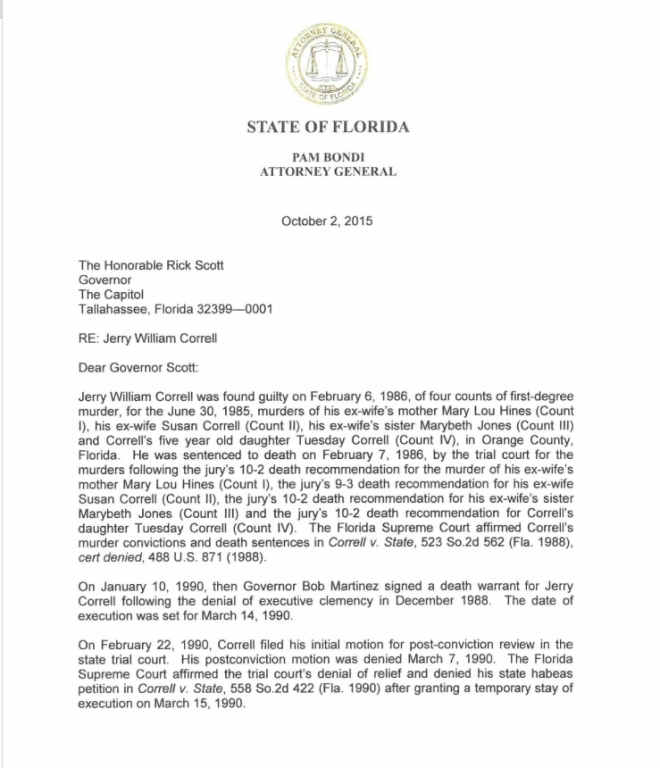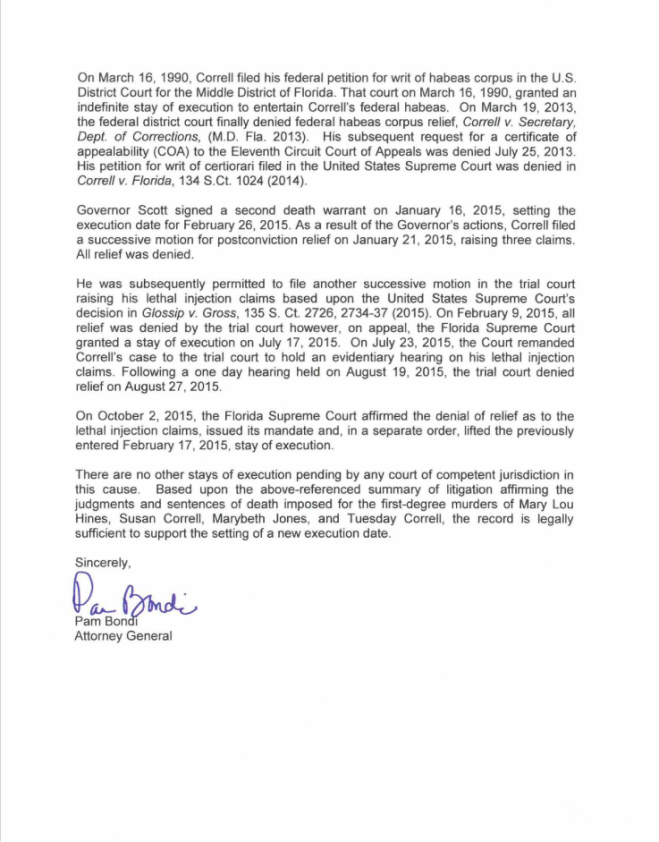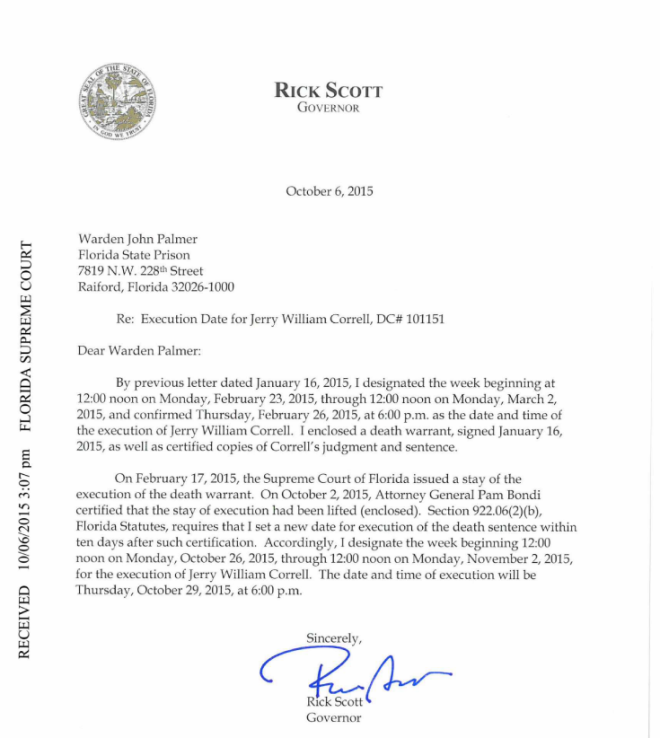In Trump’s final days in office, Lisa Montgomery — a mentally ill victim of sex trafficking — is set to be the first woman the U.S. executes in 70 years.

About a week before Christmas in 2004, Lisa Montgomery, a 36-year-old mother of four, drove from her home in Kansas to Missouri, ostensibly to buy a rat terrier puppy from a woman she’d met at a dog show earlier that year.
But it was not a pet that she was to retrieve that day. She went home with a newborn, one she acquired by murdering the baby’s pregnant mother.
On the ride home, she clamped the umbilical cord and cleaned the baby girl with wipes. For months, Montgomery had told her husband she was pregnant, even though she couldn’t have any more children — she had undergone a sterilization procedure before they met. Now, she called him to tell him that she’d gone into labor while shopping and had given birth at a clinic. Back home, the couple announced the birth of their daughter to their friends and relatives. The following day, the police arrested Montgomery at her home. The baby, who was uninjured, was returned to her father.
Montgomery, who confessed, was later sentenced to death for the “especially heinous murder” as decided by a jury who heard her trial. After playing with the dogs in the backyard that day, Montgomery strangled Bobbie Jo Stinnett, 23, who was pregnant, and cut open her abdomen to remove her 8-month-old fetus.
The Trump administration announced it was reinstating executions last summer after an almost 20-year hiatus. Since they began, the federal government has executed seven people. The only woman on federal death row, Montgomery is scheduled to be executed by lethal injection on Dec. 8 at the federal penitentiary in Terre Haute, Indiana.
If her execution goes forward, she will be the first federal female inmate to be executed in almost 70 years. Her death is scheduled a little over a month before the inauguration of President-elect Joe Biden, who has pledged to end the federal death penalty.
Montgomery has exhausted all attempts to appeal her conviction and death sentence although her attorneys are exploring possible litigation. A clemency petition asking Trump to reduce Montgomery’s sentence to life without parole is expected to be filed in the coming weeks.
There are certain crimes that are universally abhorred by the public, ones that evoke a primal response of disgust and revenge from those who hear about it. Violent acts against pregnant women and their fetuses fall into that category. But blind outrage over the brutality of the crime leaves little room for curiosity about why Montgomery committed the act, and whether she deserves the most severe penalty that exists in the criminal justice system.
Montgomery suffers from severe mental illness. These days, she requires a regimen of psychotropic drugs to function. According to her lawyers and witnesses, Montgomery suffered years of childhood abuse so severe it was akin to torture.
A survivor of incest and sex trafficking, she is diagnosed with bipolar disorder with psychotic features, complex post-traumatic stress disorder, temporal lobe epilepsy, and cerebellar dysfunction, said Amy Harwell, a federal public defender in Tennessee who is working on Montgomery’s case. Mental health experts who examined her believe that her history of childhood trauma exacerbated a genetic predisposition to mental illness that ran in her family.
“Mrs. Montgomery was psychotic at the time of the crime,” Harwell said. “She has always accepted responsibility. This is someone who was deeply remorseful, once she became appropriately medicated and had full contact with reality, although that is a situation that waxes and wanes.”
Montgomery’s case is not about whether she is responsible for the crime; she is. The question is, should she be put to death for it? Is it ethical to execute a woman for actions that cannot be meaningfully separated from her mental illness and ugly history of abuse?

Two Sisters, Two Paths
There are things children need to grow into healthy adults, among them love, praise and stability. And then there is the life that Montgomery and her siblings inhabited, one of domestic violence, dysfunction, humiliation, fear and pain.
Montgomery’s mother, Judy Shaughnessy, who was 20 at the time of her birth in 1968, drank heavily while pregnant with her daughter.
Montgomery’s father, John Patterson, a 25-year-old in the military, was also an alcoholic. He had a daughter from a previous relationship, Diane, who was four years older than Montgomery.
Shaughnessy was cruel and violent to both girls, according to a sworn statement from Patterson, who reported feeling ashamed that he did not step in to stop the abuse. As one family story goes, Montgomery’s first words as a toddler were, “don’t spank me.”
In Montgomery’s early childhood, her older sister, Diane, suffered the worst of the violence. In an interview with HuffPost — her first ever — Diane Mattingly, now 57 and a longtime state government employee living in Kentucky, described what it was like growing up in a home without love or affection.
Shaughnessy would beat Mattingly with whatever was in her hand, be it a belt or a broom, she said. She liked to take her finger and poke it hard into her chest, over and over in the same spot. But the psychological abuse targeted at her was even more damaging.
“She had this ability to find what hurt you the most and use that against you,” Mattingly said. Shaughnessy knew that Mattingly was sensitive about abandonment due to her severed relationship with her birth mother, and so she would strip Mattingly naked and push her outside the front door, pretending that she was kicked out. “She would tell me I had to leave and I couldn’t take anything with me because she bought everything,” she recalled.
The girls’ father was often away from the house for long periods, and Shaughnessy would have other men over. Often, they’d physically fight, and Mattingly would try to protect Montgomery from the chaos. Some nights, she said, Shaughnessy would leave them in the house with a male babysitter. Around age 8, she said, a man began raping her in the bedroom she shared with Montgomery, then 4, who lay in bed right next to her.
Around this time, Shaughnessy and Patterson separated, and Mattingly was removed from the house by child protective services — an act which she credits for saving her life. On her way out the door, Mattingly said, Shaughnessy leaned over and told her it was all her fault she was being taken away. Even at the age of 8, Mattingly recalled being worried about what would happen to Montgomery without her there.
“When they came to take me, I thought they were coming to take all of us. I thought they knew what was going on,” she said. As the car drove further and further away, Mattingly began to vomit. “I was thinking, she’s still back there. And they’re taking me away from her.”
In what Mattingly described as the most lucky thing to ever happen to her, she was placed with a loving foster family who showered her with affection. “They gave me unconditional love, they taught me my self-worth,” she said. Mattingly believes that by living with loving adults who nurtured her, she was able to process the trauma of her childhood and become a well-adjusted adult.
“I’ve always said that I am bruised, but not broken,” Mattingly said, her voice choked with tears. “But Lisa was broken. She didn’t have nobody there to protect her once I was out of the home.”
She did not see her again until Montgomery’s trial 34 years later.
A few years after Mattingly was removed from the home, when Montgomery was in kindergarten, her mother remarried a man named Jack Kleiner. The couple had three children in rapid succession.
By multiple accounts, Kleiner was an erratic, violent man who beat the kids and his wife regularly. His physical abuse of the children had sexual undercurrents: He would make the girls strip naked before whipping them.

On left, Lisa Montgomery around the age her stepfather began molesting her. On right, the isol
Kleiner built a makeshift shed on the side of the trailer for Montgomery, where he began molesting, and then raping, her. Other friends of Kleiner, including a plumber and an electrician, raped her in that shed, Montgomery says, as a way of collecting payment for work done around the house.
As a teenager, Montgomery confided in her cousin, a deputy sheriff, that she was being raped by Kleiner and other men — orally, vaginally and anally. “She said it was over and over, one man right after the other, and went on for hours,” her cousin said in a sworn statement. “They were also physically violent. They would beat and slap her if she was ‘doing it wrong.’ When they were done, they urinated on her like she was trash.”
He recalled that Montgomery begged him not to tell anyone, for fear that Kleiner would kill her. She also told one of her stepbrothers about the sexual abuse around that time. “Lisa told me that when these men raped her, she would go away in her mind and try not to be present,” the brother said in a court declaration.
When Montgomery was 15, Shaughnessy and Kleiner separated. During divorce proceedings, Shaughnessy admitted to the court that she had walked in on her husband raping Montgomery. “He was in her. He was pumping her,” Shaughnessy testified. While the court admonished her for not reporting it to authorities, they did not report it either. Kleiner was never charged.
At the instigation of Shaughnessy’s lawyer, Montgomery was connected to a therapist, but only briefly. The counselor noted that her mother appeared to have a “lack of empathy” for Montgomery, who was left with the distinct impression that the sexual abuse was her fault.
Connecting The Dots
When children grow up in a chronic state of fear and terror, their brains adapt to survive, explained Katherine Porterfield, a clinical psychologist at the Bellevue/New York University Program for Survivors of Torture, who has evaluated Montgomery in prison.
In response to traumatic events, children may dissociate from their feelings and their bodies to protect themselves from experiencing what is happening. If that disconnection is brought about with enough frequency and intensity, it can become more of a steady state of being, she added.
“That is exactly what Lisa Montgomery developed into, which is a person who had profound disconnection from her body, from her mind, from her experience,” Porterfield said. “Those were disconnections that were tragic in their consequences. But they were what we come to understand as neuro-physiological adaptations to survive being constantly under assault.”
As an adult, Montgomery’s dysfunctional life mimicked that of her childhood.
She married her stepbrother at 18 and gave birth to four children in less than five years, before having a sterilization procedure. According to sworn statements from her family, her mental health declined rapidly after that. She got into multiple car accidents, struggled to keep a job, moved around constantly, drank heavily, engaged in sex work and neglected her children. She was often spaced out, appearing disconnected from reality. Her children even came up with a nickname to pull her out of her trances when she was unresponsive: They called her “Martha” instead of “mom” to get her attention.
Other times, her behavior could be erratic and inappropriate. Her daughter remembered her acting like a young child in public, twirling and skipping with her arms swinging with abandon. “[N]ot only was it bizarre behavior, but it was very embarrassing for me as her daughter,” she said.
Montgomery was also prone to delusional thinking. At least five times after she was sterilized, she told people that she was pregnant. “The historic reports of her at the time are consistent with the idea that she was a completely impaired mentally ill nonfunctional person who was operating within the symptoms of her mental illness,” Porterfield said.
Montgomery was already vulnerable to serious mental illness, she added. Montgomery’s family tree, on both her mother and father’s side, is filled with psychiatric and neurologic impairment, including mood disorders, intellectual disability, PTSD and schizophrenia.
Porterfield compared the chronic abuse to pouring lighter fluid onto a spark.
In her opinion, Montgomery’s extreme childhood trauma created the conditions for her to grow into an adult with “a disconnected sense of her emotions, a tenuous hold on reality, a completely warped view of human relationships, and a split and damaged sense of herself and of her body,” according to expert testimony she provided for the defense.
In her interviews with Montgomery, Porterfield said, the woman showed symptoms of dissociation, including confused thinking, major gaps in memory, and an inability to recognize the reality of certain events. Montgomery described feeling that she was unsure whether her environment was real, and confided that she used a strategy to ground herself in reality: She would look at a tree out the window and tell herself that the tree was real if she could see it.
Victims of severe childhood sexual abuse can overcome their trauma with certain factors, Porterfield said, such as the presence of a nurturing adult who provides love and connects them to resources to promote healing.
Montgomery did not receive that.
“It’s not just the childhood maltreatment and psychological abuse and neglect, or the incredible sexual abuse by her stepfather, or the sex trafficking,” Porterfield said. “It’s also people hearing it, knowing it and doing nothing about it. And, in fact, blaming her for it.”
Women On Death Row
It is extremely rare for women to be sentenced to death, said Sandra Babcock, faculty director of the Cornell Center on the Death Penalty Worldwide and an expert on women and the death penalty.
Only around 2% of inmates on death row are women. Nationwide, only 54 women have been executed since 1900.
In the cases where women are sentenced to death, prosecutors often use gender stereotypes against the defendants, she said, characterizing them as transgressive or not normal in some way.
“Prosecutors, in their closing argument, said that she had a filthy home, that she didn’t cook and that she didn’t clean,” Babcock said. “The idea that that evidence of her bad mothering is part of what the jury could rely upon as a reason to sentence her to death … it’s something you would never find in a case of a man.”
Babcock said the constant in every case she has seen is an overwhelming history of trauma. “Her case is one of the most extreme of all the cases that I’ve looked at, in terms of the severity and repetition of the violence that she experienced,” she said. She faulted Montgomery’s defense team at the time of the initial trial for failing to connect the dots between Montgomery’s childhood trauma and her later behavior.
Babcock noted that while at least a dozen other women across the U.S. have committed a similar crime in the past 20 years — killing a pregnant woman to kidnap her baby — Montgomery was the only one sentenced to death. In the other cases, she said, prosecutors opted not to seek the death penalty or juries did not impose it because it was obvious the women were suffering from profound mental illnesses.
Montgomery’s entire life was marked by people who failed to protect her, Babcock said. Her mother and father, teachers at school who suspected abuse, and the courts who learned of her victimization when she was a teen and did nothing.
“There is a decision that has to be made, separate from guilt, about whether someone’s behavior is so morally reprehensible that they deserve the death penalty,” she said.
“People confuse punishment with culpability,” she went on. “Nobody has said that Lisa should never have been punished. They’re saying that a sentence of life without the possibility of parole is more than sufficient punishment for someone who has endured what she did.”
Last Days
Montgomery’s legal team is fighting against the clock to gather the information needed for her clemency petition, which has been complicated by the coronavirus crisis.
“We can’t travel to talk to witnesses or to prepare experts at this point,” Harwell, Montgomery’s lawyer, said. “While a six-week time period to prepare for clemency might always be unreasonable, it is particularly arduous given the pandemic.”
She meets with Montgomery regularly, she said. Often the woman, now 52 and a grandmother of 12, is knitting or doing needlepoint. It is hard to know if Montgomery understands that she is close to being executed; her mental state does not allow for much lucidity.
“If you were to meet her, it would be inconceivable to you that she committed this crime,” Harwell said. “But it is something that she carries with her and that she mourns — not only for the effect on her life and that of her family, but for the terrible effect on Mrs. Stinnett, who was killed, and also her family who was left behind.”
Mattingly, Montgomery’s sister, is planning on visiting her next week.
As her big sister, Diane feels immense guilt about leaving Montgomery behind in that broken home, so many years ago. She believes that if Montgomery had been rescued too, and given what she was given — contact with loving, protective adults — everything would have been different.
“She has been let down over and over and over again by people in authority, people who were supposed to be caretakers for her,” Mattingly said. “I am begging that somebody will finally stand up for her and say, she’s been punished enough.”





